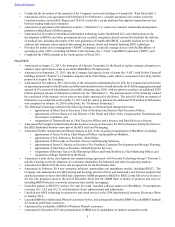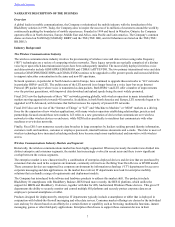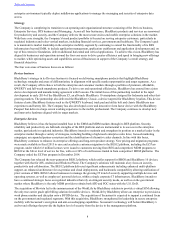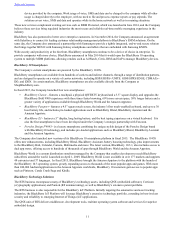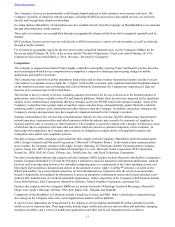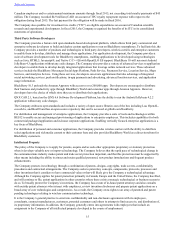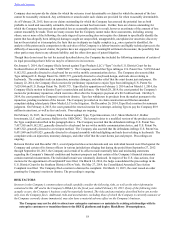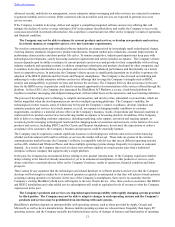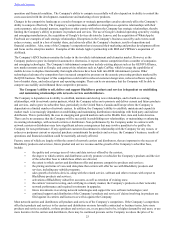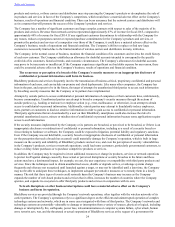Blackberry 2015 Annual Report Download - page 23
Download and view the complete annual report
Please find page 23 of the 2015 Blackberry annual report below. You can navigate through the pages in the report by either clicking on the pages listed below, or by using the keyword search tool below to find specific information within the annual report.
Table of Contents
14
A key aspect of the Company's competitive differentiation among industry participants involves the inclusion of a sophisticated
NOC in the network architecture. The Company pioneered the use of this architecture for the routing of messages to and from
mobile devices. The key benefits of the NOC are message delivery reliability, network utilization efficiency and network
security. By isolating enterprise firewalls from the devices, the mobile traffic avoids the need for numerous simultaneous
inbound connections through the firewall, which is a significant security consideration for many IT managers. Other benefits of
this architecture include eliminating the opportunity for Denial of Service Attacks against the firewall, protecting against bad
packets reaching devices, and enhancing service quality by providing advanced compression and by acting as a network buffer
between the more limited bandwidth of wireless networks and the massive bandwidth of the wired environment.
A key aspect of the Company's competitive differentiation among industry participants in the embedded software market
includes QNX’s POSIX compliant micro-kernel architecture, proprietary tools allowing developers to understand their
software’s behavior, and the in-depth knowledge of the software that QNX provides. These elements combine to allow the
QNX software to achieve certifications for medical, security and life safety critical applications.
Product Design, Engineering and Research and Development
The Company’s research and development (“R&D”) strategy seeks to provide broad market applications for products derived
from its technology base.
The Company creates innovative and robust hardware designs through complex mechanical stack up, board layout and
component integration, combined with proprietary software and firmware features. These tightly integrated solutions allow the
Company to customize its core proprietary technical solutions to address new applications, network protocols, and evolving
transmission frequencies. The Company’s tunable closed loop radio transceiver technology can be adapted to support multiple
protocols in the wireless data communications market, supporting its position as a primary supplier of wireless and related
hardware and software products. The Company has developed its own radio code stack, which it incorporates into the
processors that are deployed in BlackBerry smartphones.
The Company dedicates a major portion of its R&D investments to the development of software products and services that
meet the needs of both corporate IT departments and individual customers. These include BES12 and related enterprise
software solutions, BlackBerry 10 device and platform software, as well as device applications and server software.
Additionally, QNX has developed an embedded computing platform utilizing its unique micro-kernel OS, multimedia and
infotainment platform-specific middleware, as well as acoustic processing products. This QNX Neutrino OS is the basis for
BlackBerry 10 smartphones and supports the integration of all hardware components and security features.
The Company’s R&D efforts are focused primarily on the following areas:
• developing productivity focused devices for current and emerging wireless network technologies and market
segments;
• evolving the functionality, security and performance of its BlackBerry wireless solution and BlackBerry
smartphones;
• developing core technology and platforms for next generation air interfaces and networks, including evolution
of 3G and 4G wireless networks;
• developing value-added services and other enterprise software solutions;
• building device software including operating systems, radio code, graphics and media frameworks, application
runtimes, networking technologies, and BlackBerry applications;
• developing server and desktop software for enterprise and consumer environments;
• developing infrastructure systems to provide the underlying support for wireless network and Internet
connectivity;
• providing a platform and tools for third party software developers and enterprises to write and wirelessly enable
applications;
• improving manufacturing and testing technologies; and
• developing accessories and smart companion products to be used with BlackBerry smartphones.
The Company also engages in longer term fundamental research both directly and by selective funding of university research
projects.
The Company endeavors to take advantage of specific government and academic financial assistance programs
to support its research activities where available.
The Company previously entered into a project development agreement with Technology Partnerships Canada (“TPC”), which
provided partial funding for certain research and development projects. Funding received by the Company from TPC was for a
development project under which total contributions from TPC have been $23.3 million. The Company had fulfilled all
prerequisite funding conditions and recorded all of the contributions as at February 28, 2004. This contribution is repayable to
TPC in the form of a royalty of 2.2% on gross business revenues, subject to the Company maintaining a minimum number of



